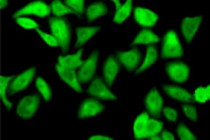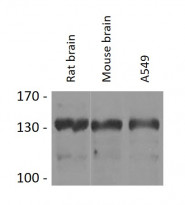ARG59799
anti-USP8 / UBPY antibody
anti-USP8 / UBPY antibody for ICC/IF,Western blot and Human,Mouse,Rat
Overview
| Product Description | Rabbit Polyclonal antibody recognizes USP8 / UBPY |
|---|---|
| Tested Reactivity | Hu, Ms, Rat |
| Tested Application | ICC/IF, WB |
| Host | Rabbit |
| Clonality | Polyclonal |
| Isotype | IgG |
| Target Name | USP8 / UBPY |
| Antigen Species | Human |
| Immunogen | Recombinant fusion protein corresponding to aa. 1-270 of Human USP8 (NP_005145.3). |
| Conjugation | Un-conjugated |
| Alternate Names | hUBPy; Ubiquitin isopeptidase Y; Ubiquitin carboxyl-terminal hydrolase 8; UBPY; Ubiquitin-specific-processing protease 8; HumORF8; Ubiquitin thioesterase 8; SPG59; EC 3.4.19.12; Deubiquitinating enzyme 8 |
Application Instructions
| Application Suggestion |
|
||||||
|---|---|---|---|---|---|---|---|
| Application Note | * The dilutions indicate recommended starting dilutions and the optimal dilutions or concentrations should be determined by the scientist. | ||||||
| Positive Control | Rat brain, Mouse brain and A549 | ||||||
| Observed Size | 128 kDa |
Properties
| Form | Liquid |
|---|---|
| Purification | Affinity purified. |
| Buffer | PBS (pH 7.3), 0.02% Sodium azide and 50% Glycerol. |
| Preservative | 0.02% Sodium azide |
| Stabilizer | 50% Glycerol |
| Storage Instruction | For continuous use, store undiluted antibody at 2-8°C for up to a week. For long-term storage, aliquot and store at -20°C. Storage in frost free freezers is not recommended. Avoid repeated freeze/thaw cycles. Suggest spin the vial prior to opening. The antibody solution should be gently mixed before use. |
| Note | For laboratory research only, not for drug, diagnostic or other use. |
Bioinformation
| Database Links |
Swiss-port # P40818 Human Ubiquitin carboxyl-terminal hydrolase 8 Swiss-port # Q80U87 Mouse Ubiquitin carboxyl-terminal hydrolase 8 |
|---|---|
| Gene Symbol | USP8 |
| Gene Full Name | ubiquitin specific peptidase 8 |
| Background | This gene encodes a protein that belongs to the ubiquitin-specific processing protease family of proteins. The encoded protein is thought to regulate the morphology of the endosome by ubiquitination of proteins on this organelle and is involved in cargo sorting and membrane trafficking at the early endosome stage. This protein is required for the cell to enter the S phase of the cell cycle and also functions as a positive regulator in the Hedgehog signaling pathway in development. Pseudogenes of this gene are present on chromosomes 2 and 6. Alternate splicing results in multiple transcript variants. [provided by RefSeq, Sep 2013] |
| Function | Hydrolase that can remove conjugated ubiquitin from proteins and therefore plays an important regulatory role at the level of protein turnover by preventing degradation. Converts both 'Lys-48' an 'Lys-63'-linked ubiquitin chains. Catalytic activity is enhanced in the M phase. Involved in cell proliferation. Required to enter into S phase in response to serum stimulation. May regulate T-cell anergy mediated by RNF128 via the formation of a complex containing RNF128 and OTUB1. Probably regulates the stability of STAM2 and RASGRF1. Regulates endosomal ubiquitin dynamics, cargo sorting, membrane traffic at early endosomes, and maintenance of ESCRT-0 stability. The level of protein ubiquitination on endosomes is essential for maintaining the morphology of the organelle. Deubiquitinates EPS15 and controles tyrosine kinase stability. Removes conjugated ubiquitin from EGFR thus regulating EGFR degradation and downstream MAPK signaling. Involved in acrosome biogenesis through interaction with the spermatid ESCRT-0 complex and microtubules. Deubiquitinates BIRC6/bruce and KIF23/MKLP1. [UniProt] |
| Cellular Localization | Cytoplasm. Nucleus. Endosome membrane; Peripheral membrane protein. Cell membrane; Peripheral membrane protein. [UniProt] |
| Calculated MW | 128 kDa |
| PTM | Phosphorylation of Ser-718 is essential for interaction with YWHAE and for cytosol localization. Undergoes dephosphorylation at Ser-718 in the M phase. Tyrosine-phosphorylated in its N-terminal half in an EGFR-dependent manner. Ubiquitinated. Inactive form is mostly monoubiquitinated, but polyubiquitination happens too. Ubiquitination is increased in EGF-stimulated cells. Ubiquitination of active form is undetectable, suggesting a possibility that USP8 deubiquitinates itself, thereby regulating its own function (By similarity). [UniProt] |
Images (2) Click the Picture to Zoom In
-
ARG59799 anti-USP8 / UBPY antibody ICC/IF image
Immunofluorescence: A549 cells stained with ARG59799 anti-USP8 / UBPY antibody.
-
ARG59799 anti-USP8 / UBPY antibody WB image
Western blot: 25 µg of Rat brain, Mouse brain and A549 cell lysates stained with ARG59799 anti-USP8 / UBPY antibody at 1:1000 dilution.







